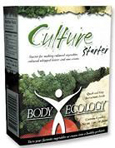How To Optimize Your Digestion With Cultured Vegetables
Including a variety of cultured/lacto-fermented foods and beverages in your daily diet is a very healthy practice because these foods are excellent for restoring and maintaining intestinal health. Everyone, particularly those with immune system issues and digestive disorders, can benefit from eating more cultured foods.
(Article by Dr. Winnie Abramson, N.D., Video with Kapila McNary)
I also recommend them for pregnant women, and for people trying to manage blood sugar issues, yeast overgrowth, and problems with weight.
My favorite cultured foods are the fermented dairy products yogurt and kefir, a fermented tea drink called kombucha, and cultured vegetables.
Cultured vegetables are available commercially at most natural foods stores. Rejuvenative Foods is a good brand, as is Real Pickles. There may be other excellent products available in your area depending on where you live.
I find most of these to be a bit pricey and prefer to make them myself for a fraction of the cost. I suggest you do the same. It is fun and easy. Many vegetables can be cultured with great success. Organic varieties are best. Possibilities include:
|
|
I prefer to use cabbage as a base and then add smaller amounts of whatever vegetables I have on hand.
Directions: Clean all vegetables well and then use the shredder blade for the food processor. If you don’t have a food processor, chop as small as you have the patience for.
Mix vegetables in a bowl. Begin to pack the vegetable mix tightly into glass jar(s). When the jars are full with about 1 -2 inches room at the top, use the handle of a wooden spoon to pound the mixture down and then add some more. Always leave 1-2 inches at the top of the jar so the fermented veggies have room to expand. I use 1 quart size mason jars, but you may use larger jars if you have them.
Then you need to add liquid. You can use a liquid made with a starter culture (available here ) if you like or you can make a brine using whey, sea salt, and water. The basic recipe is 4 Tbsp whey plus 1 Tbsp sea salt plus filtered water to fill a 1 quart jar. Shake the whey and sea salt together and pour over the veggies, then add water to the top leaving the 1-2 inches for expansion. Cap tightly and leave at room temp for 2 days, then move to the refrigerator for storage.
These keep very well and it is helpful to eat approximately ¼- ½ cup of the vegetables with meals containing proteins and carbohydrates. You can eat them alone as a condiment, or add them to salads, sprouted tortilla wraps, scrambled eggs, etc. Yum!
To make whey: strain 1-2 quarts plain organic yogurt in a colander lined with cheesecloth or paper towel over a bowl in the refrigerator overnight. The liquid that collects in the bowl is the whey. It can be used as part of the liquid for lacto-fermented vegetable recipes.
For more information and recipes, see the website of the Weston Price Foundation www.westonaprice.org and the following books: Nourishing Traditions by Sally Fallon and Mary Enig and Wild Fermentation by Sandor Katz.
About the Author:
Dr. Kendra Pearsall, N.M.D. is a Naturopathic Medical Doctor specializing in natural weight loss and food addiction. She created Enlita.com to help millions of people achieve optimal health, natural weight loss and life success with her free weekly e-newsletter (sign up at the top of this page.)



